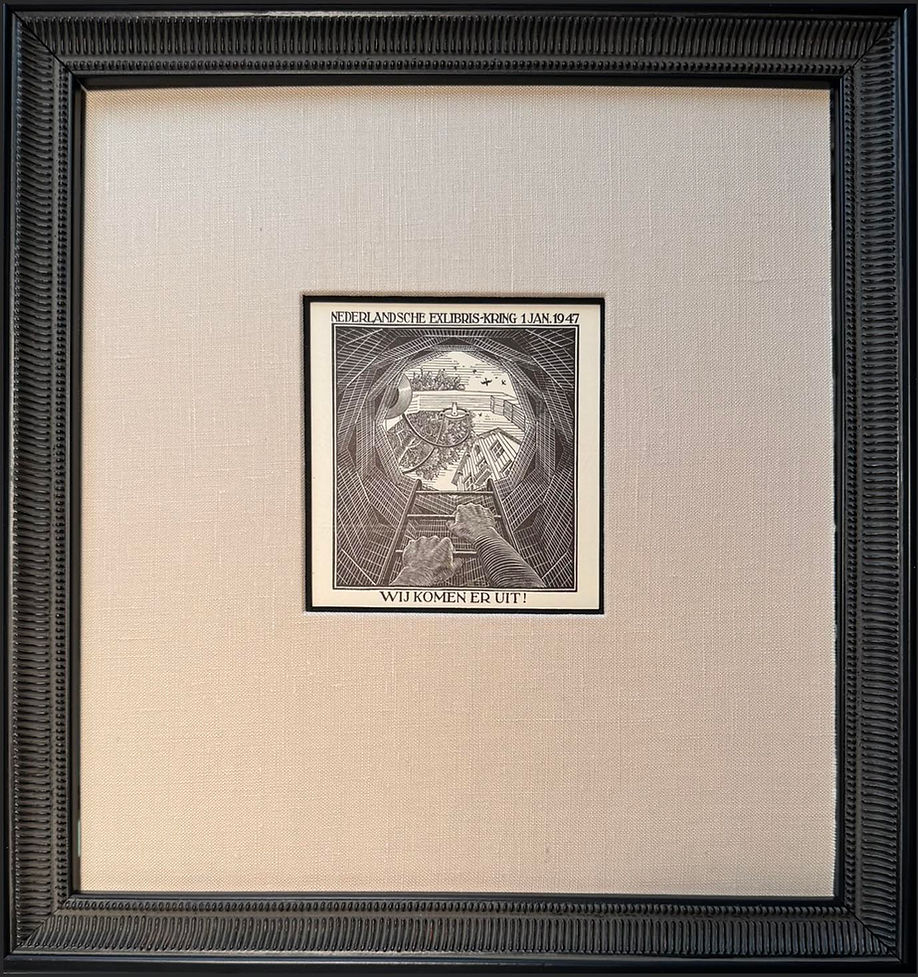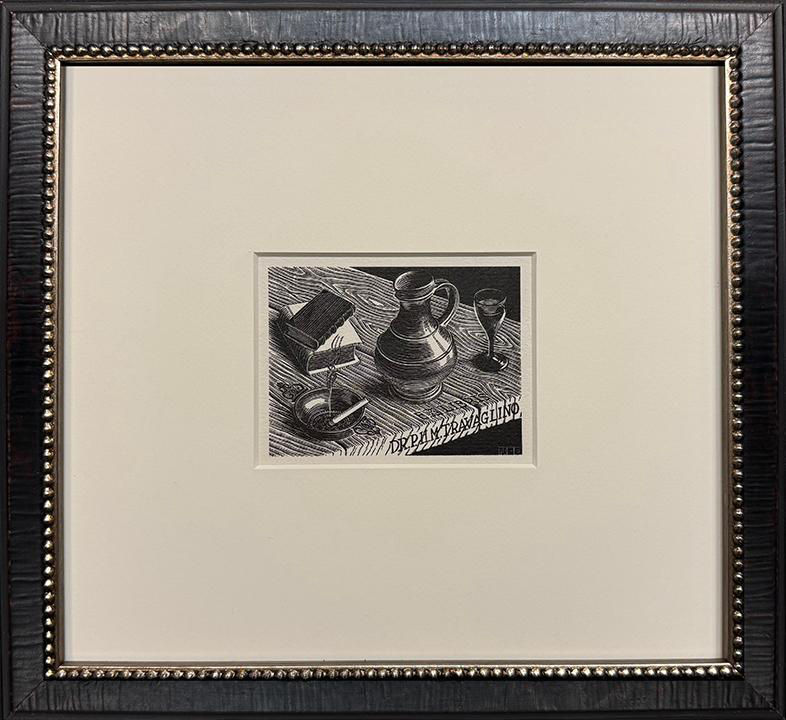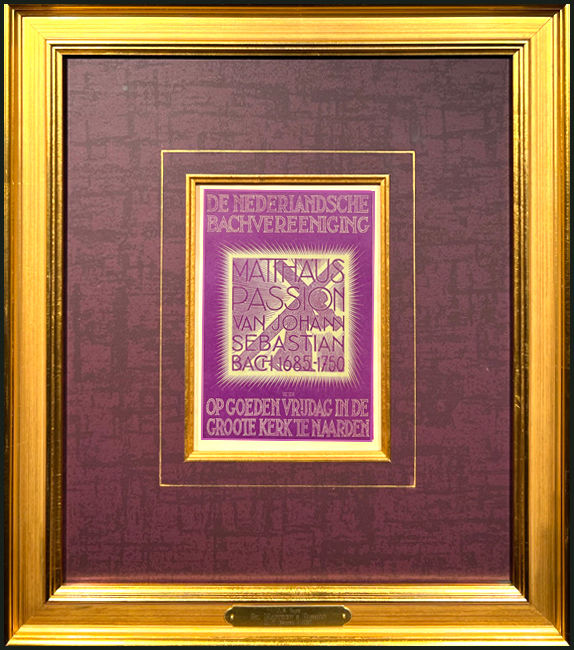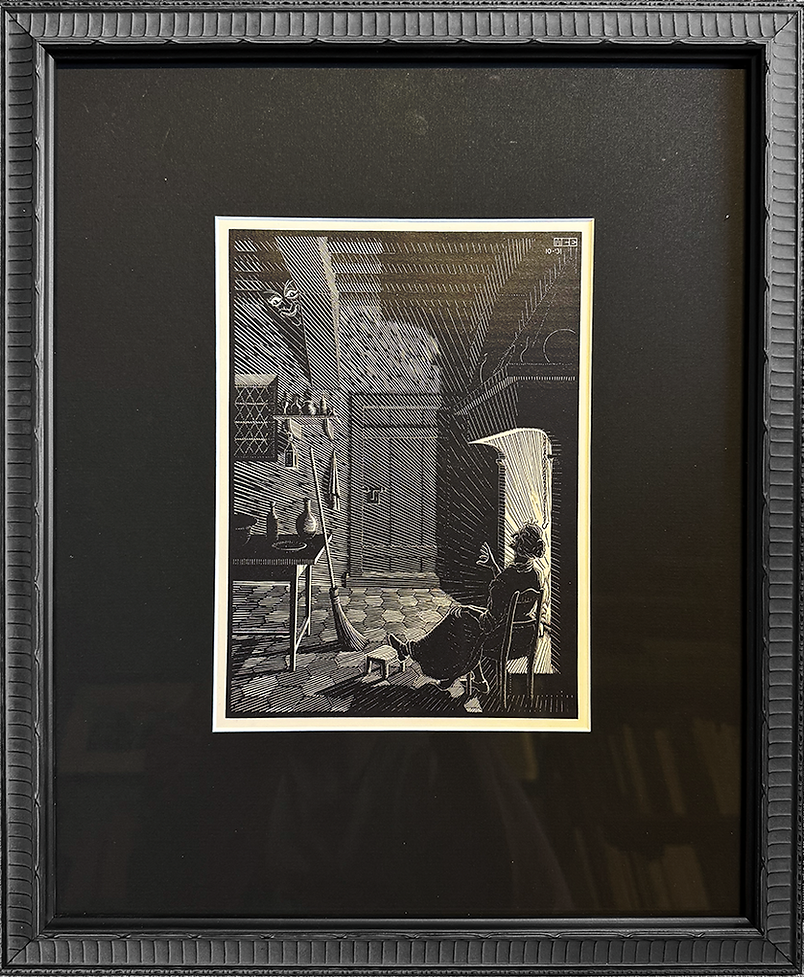

FLYING UNICORNS (B.371) 1950
Wood Engraving 12” x 11” framed

Escher’s friends and publishers, L. & K. Asselbergs, owners of The Unicorn Press, commissioned this marvelous print from the artist for their personal collection and to present to their friends and colleagues in commemoration of the 1951 New Year. Each flying unicorn exhibits a different degree of shading, creating six different levels of intensity. Breaking away from traditional symmetry, the darkest unicorn kneels in repose and thus fits seamlessly with his companions. Escher sent an example of this print to a friend 1968 with the note: “Unicorns have the reputation of bringing happiness. That’s why I offer them to you, a fraction of an infinitely large number to celebrate the coming of the new year.
$4,600

DAY AND NIGHT (B.303) 1938
Woodcut 29” X 39” framed

Often considered Escher’s greatest woodcut, here we see two similar Dutch townscapes joined by curious fields that magically transform into flocks of birds soaring into dissimilar skies. Day and night join together as do the sky and the earth, living birds and plowed fields. A closer reveals that subtle changes occur as the town is illuminated at night and birds raise or lower their tails depending on which way they travel. Escher carved two large woodblocks to print the grey and black of this image, and it was always the print that was most requested and acclaimed when Escher exhibited his prints. This example was acquired directly from Escher by Philip Morrison, a noted physicist who was an important part of The Manhattan Project

THE WELL (B.345) 1946
Wood ENGRAVING 12”X12” framed

This is considered the most powerful and complex of Escher’s small-format prints. The grid-lined walls and dramatic zenith perspective are reminiscent of the woodcut “Other World,” which Escher was working on at the same time as this print. We see hands climbing through a twisting octagonal well toward freedom – to-ward sunlight, birds, a tree in full bloom - and the security of a home.
It can be said that no country suffered as much as the Netherlands during the five brutal years of war and German occupation that ended in May of 1945. The initial celebrations soon faded as the enormity of the task of rebuilding their country overwhelmed the scant resources of the nation. 1946 brought on a terrible psychological backlash, and it became a year of depression and desperation for the Dutch people.
As 1946 drew to a close. foreign reserves weren’t even enough to buy the most basic supplies or food. Every-thing useful had been “leeggeroofd door de Duitsers,” “plundered by the Germans.” At the end of the year, the government’s catchphrase became “Wij zitten in de put maar we komen eruit,” “We are down the well but we will get out.” The Dutch people were eager to adopt the slogan and repeat it to each other, and Escher inscribed the last part of that hopeful phrase onto this wood engraving. I have chosen to translate the phrase as “We Shall Come Out of It” to capture the power of the words “We Shall Overcome” which were sung by so many civil rights protesters in the 1960’s.
Perhaps nowhere else in Escher’s art did the artist cre-ate so much emotional power through the controlled gouging of his wood-engraver’s chisel. The struggle for freedom resonates generation after generation.
The entirely unsigned edition was commissioned by the Nederlandsche Ex Libris Kring, an artists’ and print collector’s society in the Netherlands.
This is the rare second edition of this print, included in 1947 yearbook of The Netherlands Ex Libris Society
$2,700

The Heavy Heart (B.299) 1937
Woodcut 12”X10” framed

The weight of a heavy heart is dramatically emphasized by the massive weight pressing down on the thick heart. The heart is not damaged by the weight, but carries it in its center, casting a dark shadow that does not reach beyond the heart’s borders. This woodcut was created to embellish a book of poems written by Escher’s brother, J. George Escher. This is an early print of exceptional rarity.
$3,800

BOATS AND FISH (B.360) 1948
Woodcut 13”X14” framed

This is Escher’s most complete small print where landscape elements combine with interlocking forms. The sea and the sky connect on many levels, and the perfect figures interact with their surroundings. This rare work was commissioned by noted art patrons L. & K. Asselbergs, who presented it to their friends and colleagues. Karel Asselbergs was commissioner for refugees after World War II in Breda, Holland, and also had a private publishing company known as ‘Eenhoorn Pres” (The Unicorn Press). This explains why the Asselbergs commissioned Escher to create the woodcut “Flying Unicorns.” When Escher designed one of his greatest masterpieces, the extended version of Metamorphosis III in 1967, he returned to this wonderful motif of boats and fish and incorporated it into that monumental print.
$5,700

ORDER AND CHAOS (B.366) 1950 Signed Lithograph
23”X22” framed

We see here a crystal sphere, or perhaps a soap bubble, that contains geometric star piercing its skin. Surrounding the sphere, and quite literally reflected in it, is an assortment of seemingly chaotic rubble: a broken pipe, an eggshell, a cough-drop package, some pottery, glass, and bits of paper and string. But what we often perceive as chaotic is perhaps not so random after all. For example, if you were to take one of these discarded objects and examine it under a powerful microscope, you would see perfect little interlocking crystals, molecules and atoms. We don't see these orderly patterns, but they are there, disguised as chaos! Escher himself explained this with a rare philosophical remark: "I try in my prints to testify that we live in a beautiful and orderly world and not in a formless chaos, as it sometimes seems.” This comment positions “Order and Chaos” as one of the hidden keys to understanding Escher’s art.

Scholastica Flying (B.188) 1932
Woodcut 16”X18” framed

Escher was masterful at combining typography with his images, so here we see Scholastica flying through the air – and through the book’s title! - on a broomstick. One might ask, “is she a witch, or simply a woman following her passions?” Scholastica’s adventures are, indeed, terrifying, but they are also exquisitely exciting and irresistibly passionate. Escher himself was drawn to explore beyond the ordinary veil of reality, and so it is fitting that he wished to illustrate such a story.
$1,950

Rippled Surface (B.367) 1950 Linoleum Cut
Signed and noted ‘eigen druk’ (‘self-printed’) 20”X22” framed

Rippled Surface is the only linoleum cut in all of Escher’s mature work, and the result is perhaps the most fluid and lyrical in all of the artist’s work. The moon’s reflection, a hollow circle, is overlaid with a complex cascade of black branches. These patterns themselves are quite beautiful, but it is the two ripples on the water’s surface that create a sublime and transcendent experience on this thin Japanese paper. Escher designed these elliptical rings on graph paper, and they follow exacting rules of regularity and perspective, and yet they are as natural as a breeze shimmering across the surface of the water, creating patterns that remind us of the vibrations of music as well as the wind. Here we are witness to both the distant stability of the moon, seen here as a hole in the sky, the intertwining patterns of the earth-bound trees’ reflections, and the ephemeral dance of the momentary ripples on the water’s gray surface. The effect is deeply resonate and subtly breathtaking.

Table Still Life (B.321) 1940
Woodcut, Signed with initials, 9”X10” framed

This was Escher’s first commissioned print following the transformation of the artist’s work after his return to Holland. Dr. Travaglino was a psychologist, and we can only imagine the impact Escher’s work had on him. The table pushes forward and the objects show an astonishing range of materials and textures. We see glass, wood, metal and paper; even the transparency of liquid and the delicate wisp of smoke rising above the ashtray.
$3,250

The Volcano (B.91) 1922
Woodcut 12”X12” framed

Escher created this dramatic woodcut for his brother, Berend, who was a geologist. It was Berend who introduced Escher to the mathematics involved in crystallography, and this contributed greatly to the artist’s understanding of complex repeating patterns. In this print the reflections of positive and negative shapes are quite remarkable. The shift in the falling ash from white on black to black on white prefigures such important works as Escher woodcut "Sky and Water." The Art Deco typeface Escher used appears in a later print and is closely related to the classic lettering on the cover of the catalog raisonné of the artist: “M. C. Escher: His Life and Complete Graphic Work.’
$1,400

St. Matthew's Passion (B.302) 1938
Woodcut (13” X 11” framed)

Escher has used several devices to strongly focus the viewer’s attention: radiating lines converge at crossed diagonals in the composition, and there is a letter-circle surrounding the head of Christ. The pointillist patterning in the design and the positive/negative radiating lines in ivory and violet are especially interesting elements of this dramatic print. The overlapping letters in Bach’s name shows Escher’s concern with innovative use of typography. Escher revered the work of Bach for its structure and dramatic balance, and he wrote that he would often play Bach’s music while he created his prints.
$975

Earth: Ants (Color Variant) (B.382.) 1952
Metal Plate Print 12”X12” framed

Here “Earth” is represented by a conjunction of ants which jiggles visually like swarming ants on a busy anthill. In addition to the complex design of the intertwining bodies of the little creatures, Escher creates sweeping arcs and intersections with the white-inked lines surrounding each ant. Escher’s original drawing used dramatically contrasting colors, but when Escher chose the inks for first version of this print in 1953 he decided upon deep earthy colors. Escher revisited this design in 1959 when he created a special edition to honor Eugene Strens. For this printing Escher returned to his original idea of the two ants having great contrasts, so the brown ants are now shown in brilliant orange, creating astonishing visual excitement.
$3,200

The Apparition (B.191) 1932
Woodcut from “Scholastica” (16”X 13 ⅝” framed)

This is a moment of revelation for Scholastica. She was down in her dark basement, hungry and hoapeless. She had not had a good life, and there was little hope of things getting better. Then she saw in the flickering firelight a shadow appear to move in the eaves. She looked again and saw it was a face, and though the face was frightful, she was drawnto it nonetheless. As she peered into the darkness she saw a small jar on the shelf. Scholastica reached for the jar and pried off the lid. Inside was a greasy balm. She put her finger into the fatty salve and rubbed it on her lips. She was then drawn to the fire, grabbed the straw broom by the table, and off she went on a terrifying adventure.
